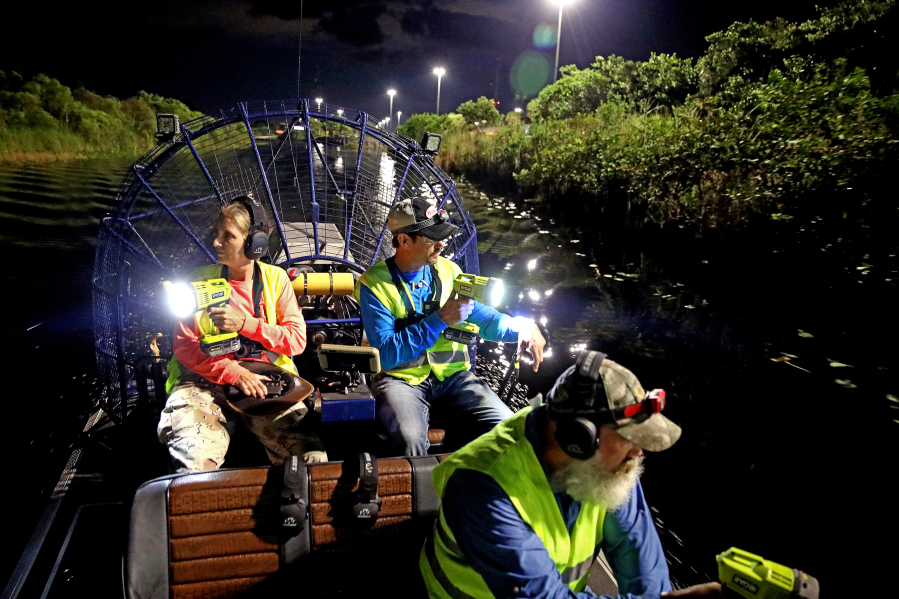MIAMI — Monsters slither throughout the crooked mangroves and serrated sawgrass of Florida’s Everglades, 20 feet long and up to 200 pounds of sinewy muscle built by devouring everything in their path.
In a state chock full of invasive birds, fish, lizards and bugs, the Burmese python reigns supreme.
Bite by bite, these invaders have reshaped the ecosystem they’ve slithered through for almost 30 years, thanks to irresponsible owners dumping their pets in the swamp when they got too big or cumbersome to care for. (The theory that they were released from a lab when Hurricane Andrew blew through in 1992? Busted.)
Scientists have found all kinds of mammals, birds and reptiles in their bellies — the nearly extinct marsh rabbit, wood storks, deer, even alligators.
It’s a five-alarm problem for a state currently spending billions on restoring the Everglades, “the largest environmental restoration in the history of the world,” as “Alligator” Ron Bergeron — a longtime python hunter, businessman and member of the South Florida Water Management District board — puts it.
“Can you imagine an Everglades with no wildlife?” he said. “You can’t have a healthy ecosystem without a healthy food chain.”
A decade ago, Florida came up with a unique way to tackle the problem. It sponsored a weeklong hunt for the pythons, drawing in would-be reptile slayers from around the world hoping for a chance at the cash prize.
The original python challenge a decade ago netted a mere 68 pythons. This year, around 1,000 registrants captured and killed 209 pythons.
Last month, the state honored the winners of the 2023 competition, which lasted from Aug. 4 to Aug. 13. The big winner was Paul Hobbs, who hunts with his father (2021’s top prize winner) Tom, his 12-year-old son Dominic and his brother-in-law Austin Park. The team slayed 20 snakes in one week and took home the top prize of $10,000.
“You just have to get out there and grind. It’s not easy,” Hobbs said. “There’s a lot of time where you’re out there catching nothing.”
Hobbs may speak for all scientists in Florida who have ever tried to pin down the snake. It seems like finding a reptile longer and heavier than a grown man would be an easy task in an environment largely filled with smaller critters, but it’s proven devilishly hard.
There is no good estimate for exactly how many pythons are out there. So it’s hard to say how much of a dent has been made in their population. The United States Geological Survey estimates “tens of thousands” of the beasts may be roaming South Florida, and they’re spreading. They’ve been spotted as far west as Naples, as far north as Lake Okeechobee and as far south as the northern Florida Keys.
“They’re an apex predator,” said McKayla Spencer, the nonnative fish and wildlife coordinator for Florida’s Fish and Wildlife Conservation Commission. “Essentially, when they become adults, there’s really nothing that preys on them.”
Except, she said, for humans. Alongside the state’s annual Python Challenge, Florida pays about 100 contractors to try to kill the snakes all year long, a program that began in 2017.
Spencer said just under 20,000 snakes have been removed since 2006, with 11,000 of those from paid contractors.
Without an exact population count to compare against, it’s hard to say if the effort is making any headway against the snake population, which can grow fast. Every female snake can lay around 100 eggs a year.
But earlier this year, a U.S. Geological Survey study came to a conclusion that many in the snake community have long seen coming: Burmese pythons are here to stay.
“Overall, eradication of pythons in southern Florida is likely impossible,” the report read.
Maybe in the future, the report said, some new technology will help find — and kill — the “cryptic and resilient” creatures. But for now, scientists say, the goal is simply to remove as many snakes as they can.
“Every python removed is one less python to harm our native species,” Spencer said.



